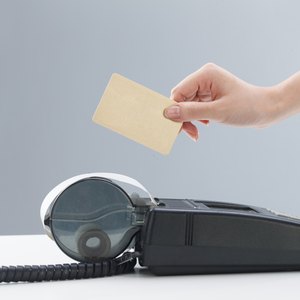
Debit cards are a great convenience, but finding out that your card doesn’t work because it’s been damaged can be a huge inconvenience. Debit cards traditionally have contained a magnetic strip that could be subject to damage, but many of today’s debit cards have an embedded smart chip that makes them vulnerable to damage in new ways.
Damage to Card
To use a debit card at a store or an ATM, the card needs to be scanned or swiped. Harm to the card itself may prevent this, however. Things such as creases or breaks can make the card unusable. In general, plastic cards are resilient and might still work even after getting wet and being dried off . However, leaving a card in a hot vehicle can warp the card’s surface and make it unusable, as can freezing the card.
Damage to a Magnetic Strip
The black magnetic strip on the back of many debit cards is used to encode the consumer’s identifying information. Scratching the strip or damaging it in any way that makes it impossible to read will render the card useless. It is also possible to demagnetize the strip on a debit card by exposing it to a magnet, resulting in the information on the magnetic strip becoming unreadable. The magnetic closures on some purses and wallets are frequently to blame for damaging a debit card. To avoid demagnetizing debit and credit cards, magnet manufacturers recommend keeping magnets at least an inch away from a card’s magnetic strip. Putting a credit card next to a smartphone, such as putting it in the phone's case for safekeeping, also can cause a strip to demagnetize.
Damage to Smart Chip
A smart debit card, also known as an EMV (for Europay, MasterCard and Visa) card, uses an embedded computer chip to encode consumer data more securely than the old magnetic strips do. However, the New York Times reports that smart chips can become damaged by scratches from keys, coins and sharp objects. Chips can also be damaged by liquids, including water. There also have been cases reported of chips falling off debit cards. In all of these instances, the debit card probably will have to be replaced since the smart chip can no longer be read.
Reporting a Damaged Debit Card
It’s important to let your financial institution know as soon as possible about a damaged debit card, especially if you want to request a replacement card. You might have to call a toll-free number, but many banks and credit unions now allow you to report damaged, lost and stolen cards online or from a mobile device.
References
- K&J Magnetics: Credit Cards and Magnetic Stripes
- New York Times: Caring for Smart Chip Cards
- You need to stop putting things in between your case and your phone
- American Bar Association. "Automatic Teller Machines (ATMs) and the Law." Accessed March 24, 2020.
- CVV Number. "What Is My CVV Number and How Do I Find It?" Accessed March 24, 2020.
- Huntington National Bank. "How to Use a Debit Card: Online, ATM & Chip." Accessed March 24, 2020.
- Consumer Financial Protection Bureau. "What Is the Difference Between a Prepaid Card, a Credit Card, and a Debit Card?" Accessed March 24, 2020.
- Visa. "Visa Prepaid Reloadable Personal Cards." Accessed March 24, 2020.
- Consumer Financial Protection Bureau. "Understand the Fees You Will Pay." Accessed March 24, 2020.
- Federal Trade Commission. "Lost or Stolen Credit, ATM, and Debit Cards." Accessed March 24, 2020.
- Consumer Financial Protection Bureau. "What Is a Grace Period for a Credit Card?" Accessed March 24, 2020.
Writer Bio
Catie Watson spent three decades in the corporate world before becoming a freelance writer. She has an English degree from UC Berkeley and specializes in topics related to personal finance, careers and business.
